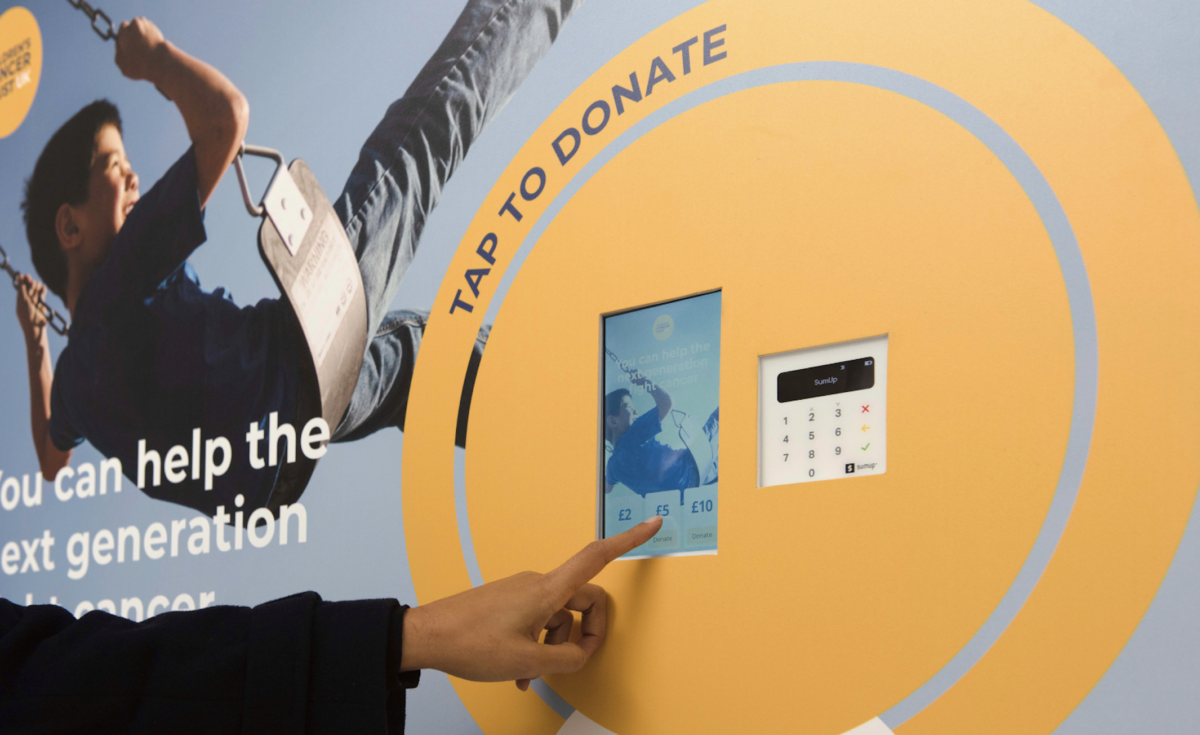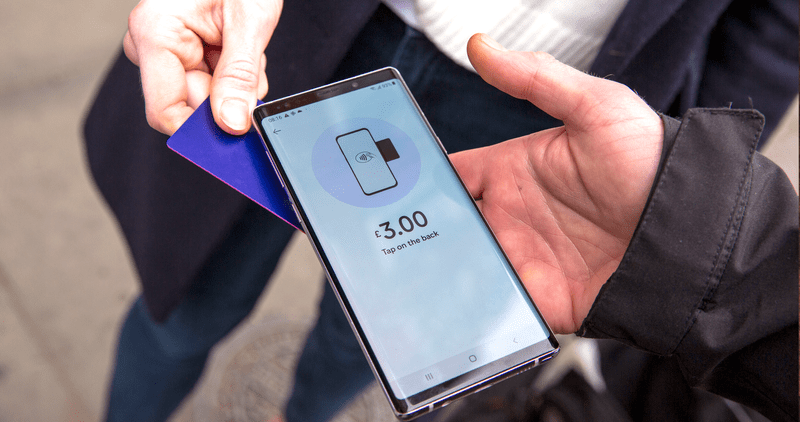Moving on from the cash-only collection tin: solutions & tips

With the pandemic accelerating the decline of cash use in the UK, recent figures show that almost 70% of Debit card transactions in the UK are now contactless. It means we can only expect the demand for contactless ways to donate to rise further.
In fact, donating via digital wallets is now almost as popular as making a gift using Direct Debit or credit card, according to the 2022 goDonate Online Donations Report. This shows year-on-year growth in their use with the ease of using fingerprint or face ID (rather than entering card details) increasing conversion. Last year, the number of one-off ApplePay donations increased by 60% compared to 2020. GooglePay, although used less, jumped by 45%.
Chris Kane, Head of New Business at GiveTap observes:
Advertisement
“Over ten million people in the UK now use contactless mobile payments. Mobile wallet transactions accounted for 32% of retail payments in the UK in 2020 and the figures continue to rise. Due to the biometric security features of these payment types, there is no upper limit on transaction size so we regularly see donations above £1,000 with them.”
Contactless technology provider GoodBox saw the number of individual contactless donations it handled increase from 32,000 in May 2019 to 78,000 in May 2021, while over the last 12 months donations through the CollecTin More have increased from around £50,000 in March 2021 to £240,000 in March 2022.
Chris Allwood, Co-founder of CollecTin.com, comments:
“Nearly every charity who contacts us talks about people no longer carrying cash. It was a trend before the pandemic, but it has been accelerated by it.”
It means that any charity that isn’t already doing much in the way of accepting contactless donations is likely to be thinking about it. Those that are will be keeping a close eye on developments and trends to help guide future activity.
One fundraising method impacted by the decline in cash use is of course the bucket – or tin – collection. Here’s a quick look at what solutions are being used instead, followed by some tips to help guide the decision-making process.

Popular cash-only donation alternatives
Think of cashless giving, and contactless tap-to-donate solutions, QR codes, and mobile giving immediately spring to mind.
Broadly speaking, the options fall into two main camps. Firstly, card-based collection methods, where the charity enters into a contract with a card processor and places a card-payment processing machine – manned or unmanned – in a prominent location to attract card donations. Examples include tap and give devices in shop windows, manned and unmanned donation points at venues and events, like those often dotted around museums and zoos and replacements for the traditional collection plate in churches and mosques.
Secondly, and gaining ground, are open banking-based payment methods. These allow anyone with a UK bank account to get paid by anyone else with a UK bank account. There are a number of benefits driving uptake, as Ian Gass, CEO of Bopp Payments explains:
“This is the next big thing for charities. There are several advantages to charities adopting this new payment method, from ease of use (donors only need a banking app in order to pay), to security (no card or account security detail are exposed so it is extremely secure), and the lack of any need for hardware, which means charities can simply generate QR codes or weblinks to get paid, and can be paid from anywhere. Some providers also allow for Gift Aid data collection as part of the service. There are hundreds of charities across the country using this payment method already, but it’s the tip of the iceberg.”

Up & coming
Tap on phone and tap on glass technologies are also predicted to grow. GiveStar announced its Tap-on-Phone app last September. This allows fundraisers to take contactless donations with just their smartphones with donors tapping the screen instead of a card reader. British Red Cross recently trialled the technology alongside cash buckets at Twickenham during England’s Six Nations game with Ireland. Raising funds for the DEC Ukraine Humanitarian Appeal, the charity trialled the technology alongside cash donations, increasing the amount raised by 30%. The Big Issue also recently announced that it is rolling out the technology to its vendors through Zettle by PayPal.
Vicky Hewlett, Give A Little Senior Community Manager says:
“Cashless fundraising is always evolving. ‘Tap on Phone’ and ‘PIN on Glass’ technologies will enable charities to accept contactless and Chip + PIN donations without needing a separate dedicated card reader. This is a very flexible option for charities to use when they are deploying volunteers to take donations, as volunteers can use their own phones (or the charity can issue cheaper Android tablets or phones).”
Top tips for decision making
So how do you decide what’s right for you, and how do you make contactless fundraising a success? Here are some tips from the experts, from ensuring it meets your key requirements, to experimenting with donation amounts, using QR codes, choosing a solution that provides useable data, and of course, making sure whatever you implement is easy to use for donors.
Charity specific device or not?
While many charities use devices designed for the sector, others opt for those designed more for business use. One thing worth noting with these though is that they won’t include some of the features of those designed specifically for charities. Alex Coleridge, Co-founder of GiveStar explains:
“It’s not just about the transaction, but what sits behind it – those charity features, like backend reporting and the ability to add Gift Aid that comes with a charity focused device are really important. That extra 25% provided through Gift Aid outweighs any platform fee that you might see attached.”
Identifying key requirements
Gass’s top tip is this:
“Select a collection method that meets your key requirements. That could be cost, convenience, security or other. There are good options on the market from the traditional to the newer methods, and many are incredibly easy to try out with no complicated onboarding process or cost. With Open Banking the barrier to entry is whether the charity has a UK bank account which is always yes!”
Encouraging giving
Hewlett shares her tips:
“Experiment with different donation amounts (we see average donation values of £10.49 through our app campaigns and £40.29 through our web campaigns) and make sure you offer ways to pay that donors are familiar with, such as Apple Pay and Google Pay. And we always recommend that charities make their campaigns really engaging by customising them with a compelling message, photos or video and their logo as this will help maximise donation revenue.”
Coleridge adds:
“The biggest driver we have found for making a donation is the ask. Offering contactless is essential but it’s not a magic bullet. You still need to do the fundraising, and to think about how to incorporate contactless and QR codes into your fundraising in a natural way. Signposting is also important so that people realise you accept contactless donations as well as cash.”
Making use of QR codes
Vicky Reeves, Managing Director at goDonate says:
“I would strongly recommend that you have QR codes displayed on the unmanned donation tins that take you to a mobile first donation funnel. What I love about QR codes is that you can capture lots of great data (e.g. which QR code it is, where it is, which unmanned tin it is etc) and importantly you can also get donor information and consent for further communication. When offering a donation form via QR code it is essential to offer digital wallets such as Apple Pay and Google Pay so the donation experience is fast and frictionless on a mobile device.”
Location considerations
GiveTap’s Kane shares:
“Manned solutions often drive much more income for charities than unmanned but the environment and location play a large factor. With manned stations a fundraiser or volunteer can attract the attention of the donor, even in busy environments with lots of background noise. For example, in a train station most people are in a rush. A confident fundraiser can briefly catch their attention and get a donation whereas a static display will likely go unnoticed.
“In a church, museum or at a club meeting, unmanned solutions are highly effective because there’s little background noise and there is an expectation of a donation. In this scenario it can be easier to communicate the fundraising ask and donors have a better understanding of what is expected of them.”
Don’t forget cash altogether
Laura Pollard, GWD Marketing Manager says:
“Let’s not forget about inclusivity. Moving away from cash as a society has its drawbacks. People still need and use cash. For instance in some faith communities, this is still the prevalent way to give an ‘offering’ during a service. So, make your fundraising flexible. Allow for a hybrid approach, ensuring there are a number of ways to donate across your fundraising touchpoints using your knowledge of your supporter community.”
And some final tips for long-term success
Jenna-Mae Luby-Young, Senior Marketing Executive at GoodBox advises:
“Choose a data-driven solution. This makes admin and devising future strategies that much easier. Keep your donors updated too, either through your database or on social media. Let your donors know how their donations are impacting your mission. This will also drive future contributions. And of course, make donating easy; whether you provide a cash box, contactless giving device, QR code or an online giving page, making the process as simple as possible will always be a winner.”




